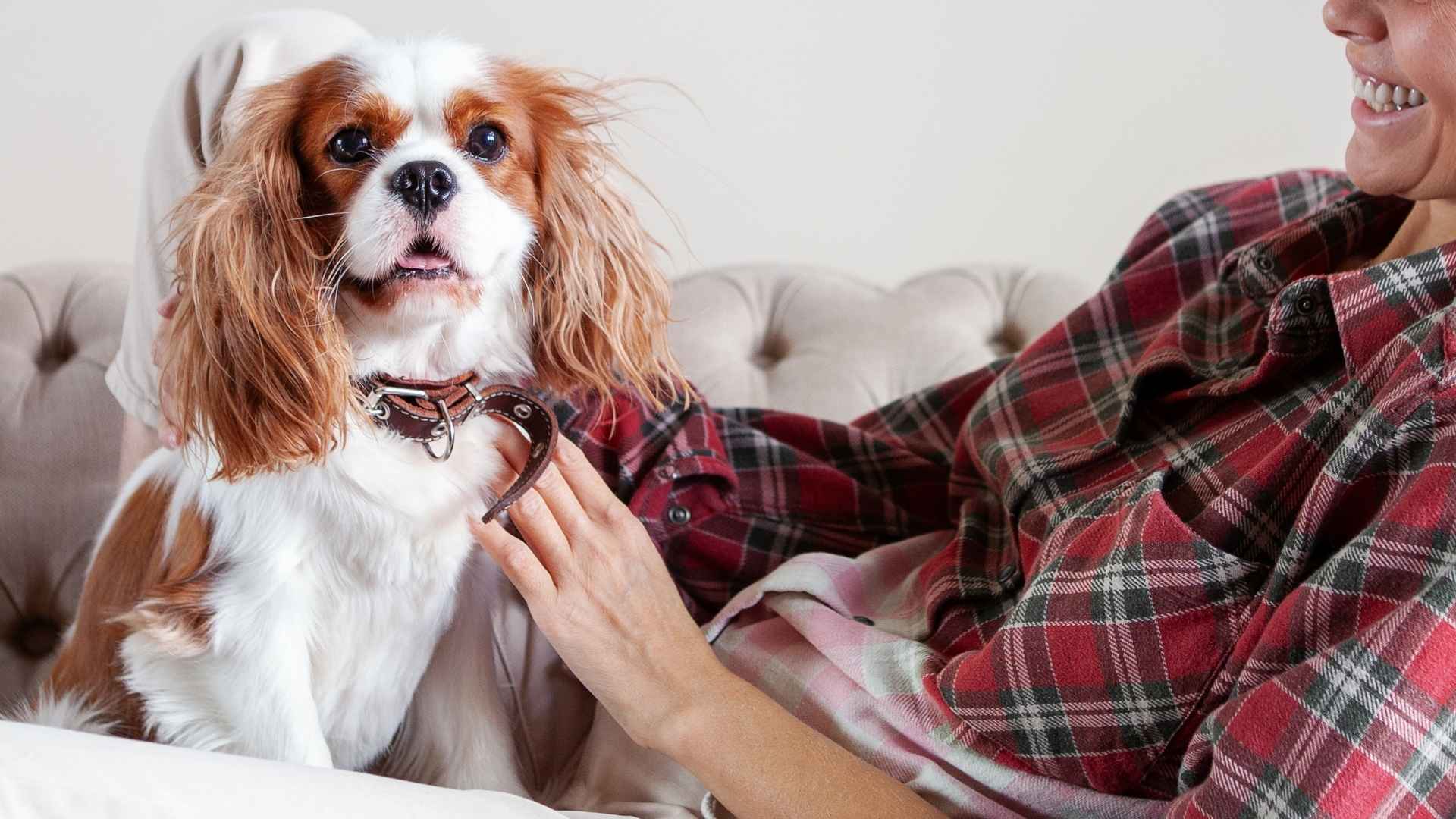So, you’re finally ready to add a furry friend to your life—cue the excited tail wags and the endless name brainstorming. But wait, not all dog breeds are created equal when it comes to newbie owners.
Some dogs are basically born with a “User Manual for Humans,” while others might require a PhD in dog psychology and a full-time walking schedule. If you’re new to the dog world, it’s smart to start with a breed that’s a little more forgiving—and a lot more fun.
Whether you’re living solo in a city apartment or starting a family in the suburbs, the good news is that there are plenty of dog breeds that are known for their trainability, patience, and easy-going nature. These pups don’t need you to be a canine expert—they just need a loving home, a daily walk, and maybe a treat or two (okay, three).
Here, we’ll introduce you to the best dog breeds for first-time owners—dogs that won’t judge your beginner mistakes, love a good cuddle, and are just as excited as you are to start this journey together.
Dog Breeds Suitable For First-Time Owners
1. Whippet
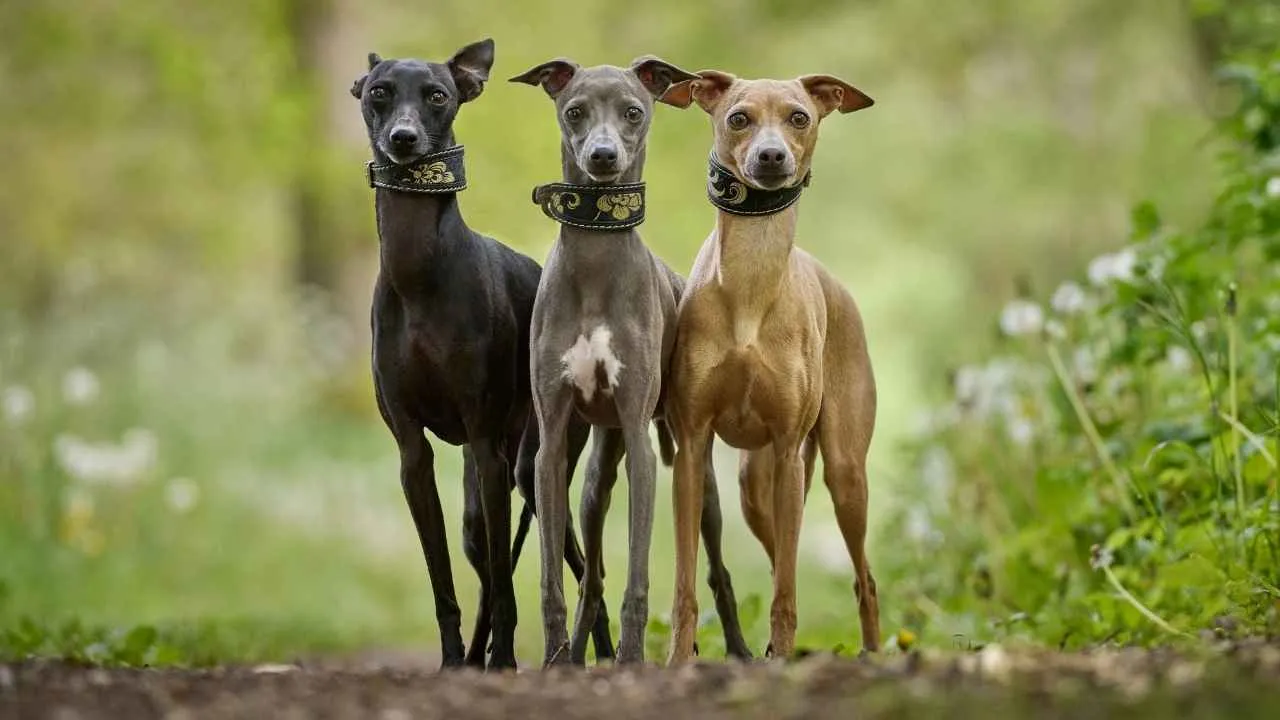
If you combined a race car with a throw blanket, you’d get a Whippet. These slender speedsters may look like supermodels of the dog world, but under all that elegance is a laid-back, affectionate pup who just wants a soft couch and your undivided attention.
By the 2000s, Whippets had become one of the most favored dog breeds in the U.K. Typically measuring between 18 and 22 inches at the shoulder, they feature a slim, graceful frame with a deep chest, long neck, tapered waist, and refined legs.
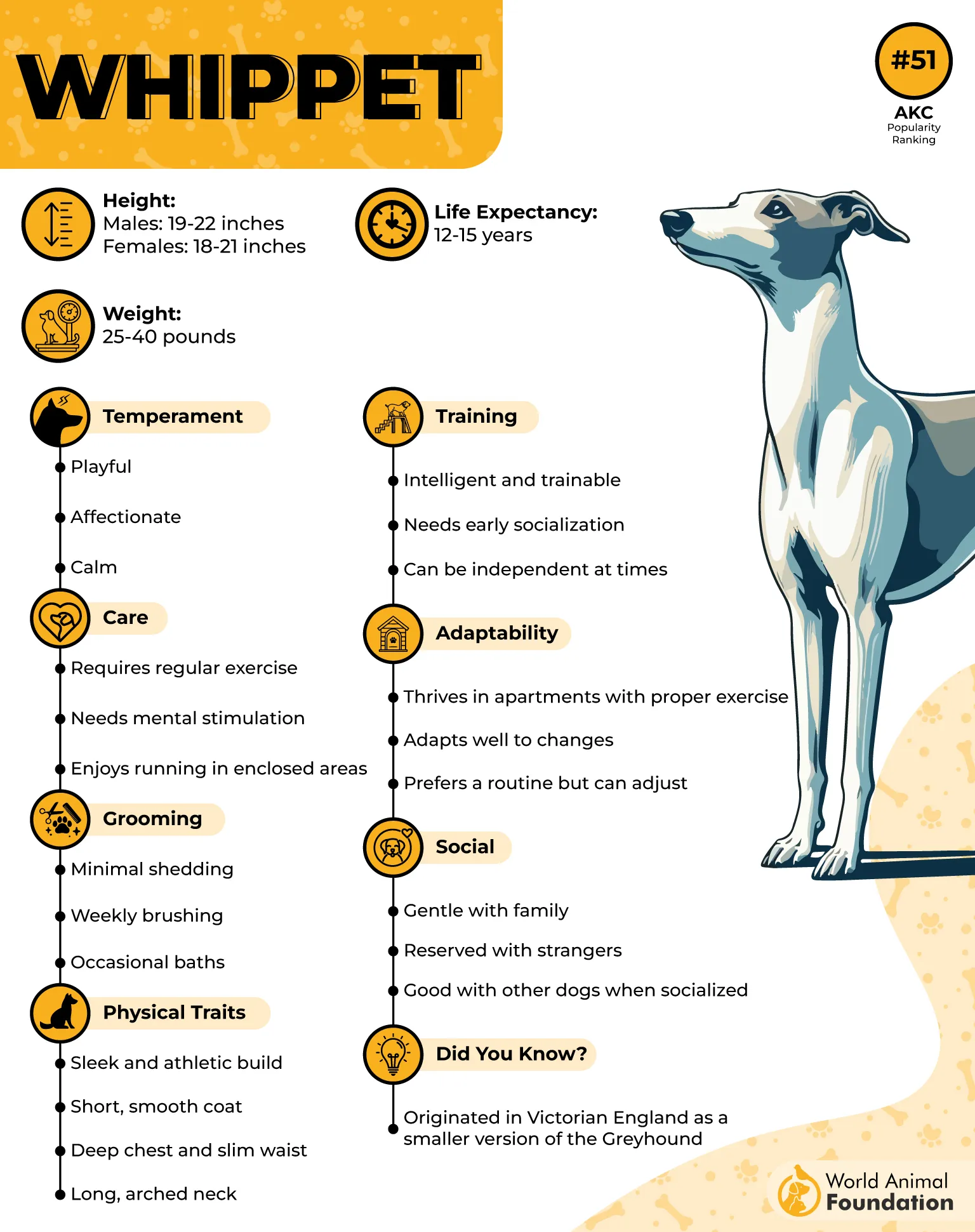
Whippets resemble miniature Greyhounds and were originally developed by breeding these swift racers with smaller terrier breeds. Whippets usually get along well with strangers and other pets. However, a household with noisy, energetic young children may be overwhelming for these gentle dogs.
Speed? Insanely fast. Like, “blink and you miss it” fast.
Energy at home? Surprisingly chill. These highly intelligent dogs love a quick run, then they’re down to nap for 20 hours.
Bonding? Deep. They imprint on their humans like you’re the only person in the world—and they mean it.
Whippets are the definition of “quiet companion.” They rarely bark, don’t need intense exercise, and won’t eat your houseplants out of boredom—unless they’re left alone too long. These dogs really love their people. A bit of separation anxiety isn’t uncommon, so they do best in homes where someone’s around most of the time, PDSA says.
Weekly grooming sessions are ideal for checking your Whippet’s overall health and spotting any problems with their skin, eyes, or teeth. While Whippets are generally low-maintenance, they still require regular care and routine veterinary check-ups like any other dog.
2. Cavalier King Charles Spaniel
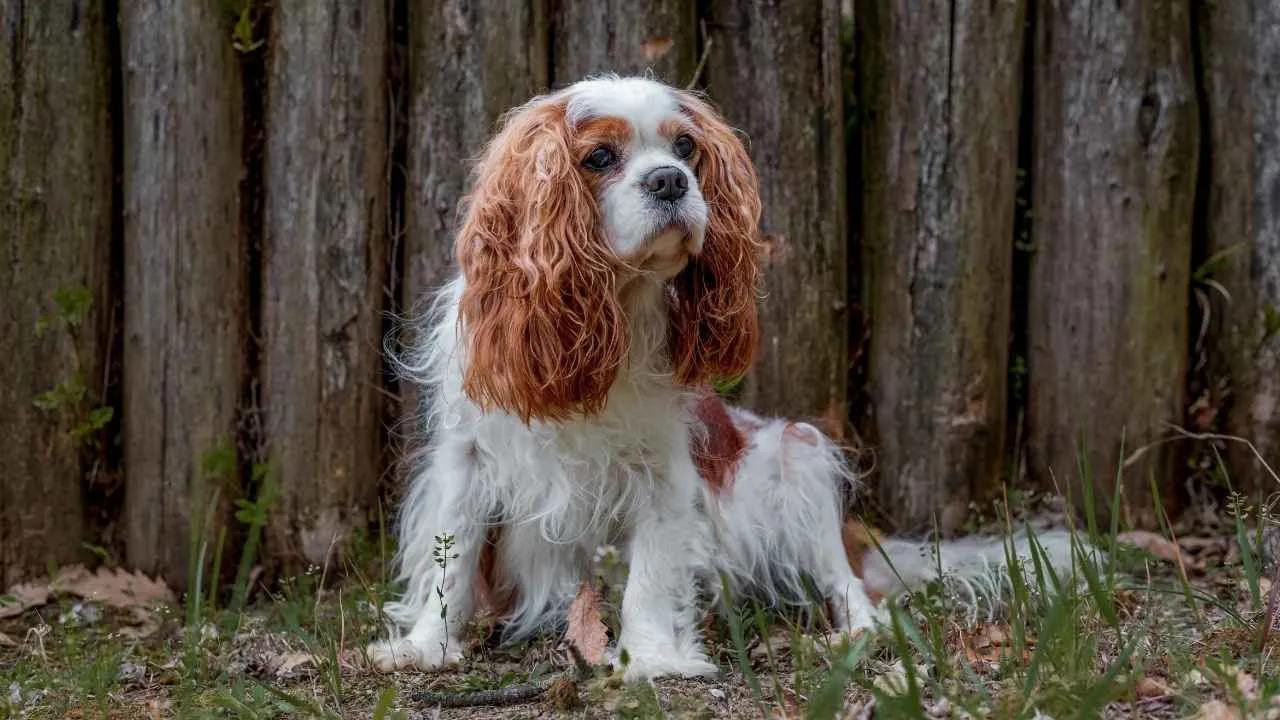
Imagine the politest little dog you’ve ever met, with silky ears, soft eyes, and a heart as big as their name. The Cavalier King Charles Spaniel is elegance on four paws—equal parts lapdog, listener, and emotional support sponge.
Cavalier King Charles Spaniels were originally bred to cozy up on laps in drafty castles and chilly carriage rides. Known for their friendly and gentle temperament, they’re a perfect pick for first-time dog owners. Currently, they rank as the 14th most popular dog breed.
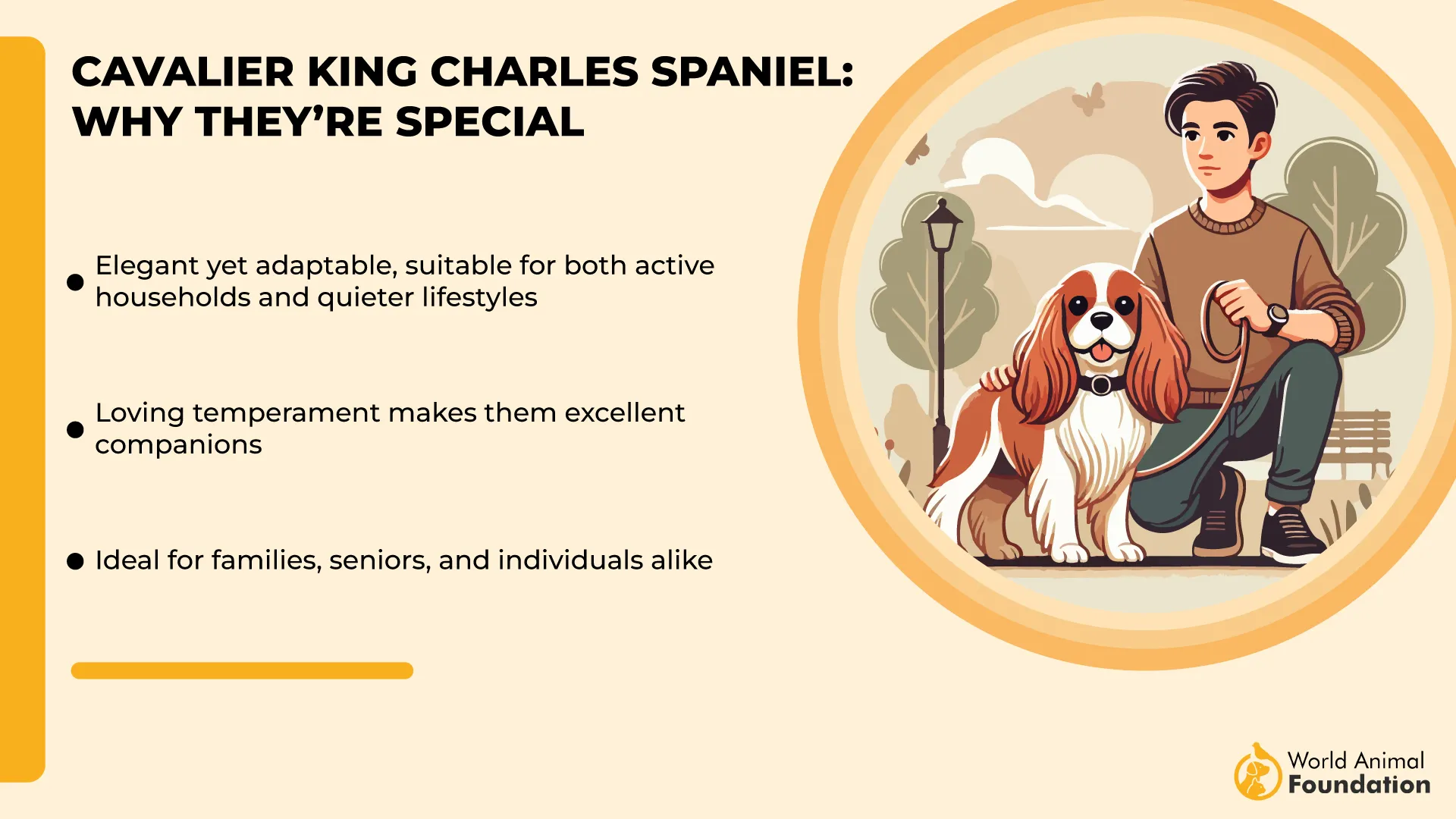
These small pups typically stand 12–13 inches tall and weigh between 13 and 18 pounds. Their signature features include naturally floppy ears, a long back, a compact body, and a deep chest. Cavaliers sport a silky, long coat that appears in four distinct color patterns.
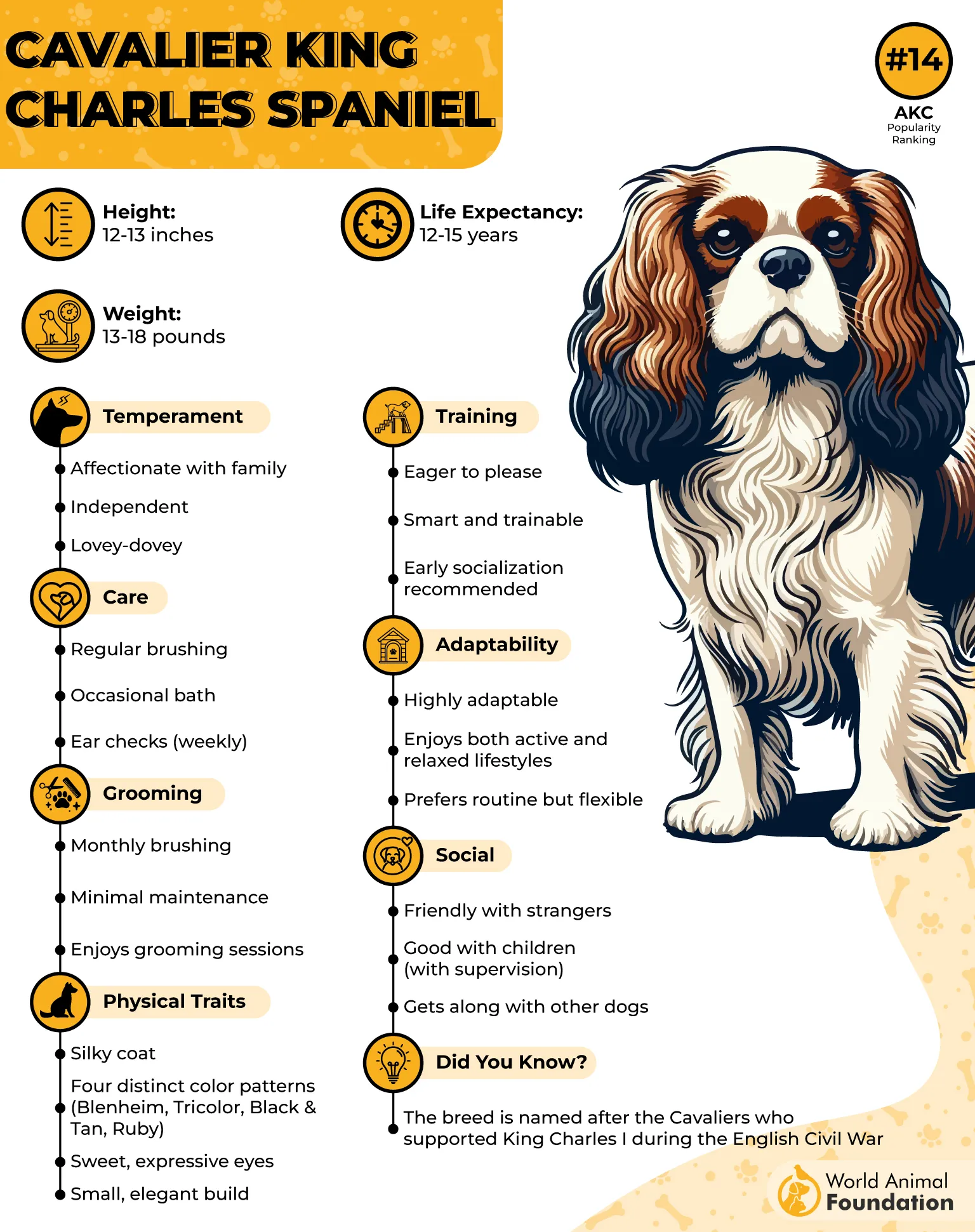
Vibe? Graceful, calm, and emotionally intuitive
Exercise needs? Very manageable. A stroll around the block and some indoor playtime usually does the trick.
Family-friendly? Extremely. They love everyone, including other pets.
Cavaliers were practically designed to be excellent companion dogs. They don’t bark much, aren’t overly hyper, and seem to have a sixth sense for when you need a cuddle. They’re incredibly gentle, affectionate, and eager to please—like a walking, tail-wagging hug.
They’re wonderful family dogs—tolerant, patient, and great with kids and other pets alike. Although they were bred as lap dogs, Cavaliers come from a sporting lineage and enjoy moderate exercise and outdoor fun.
Whether you’ve an active lifestyle or are more laid-back, as long as you commit to daily walks and playtime, Cavaliers will thrive and happily adapt.
3. Boston Terrier
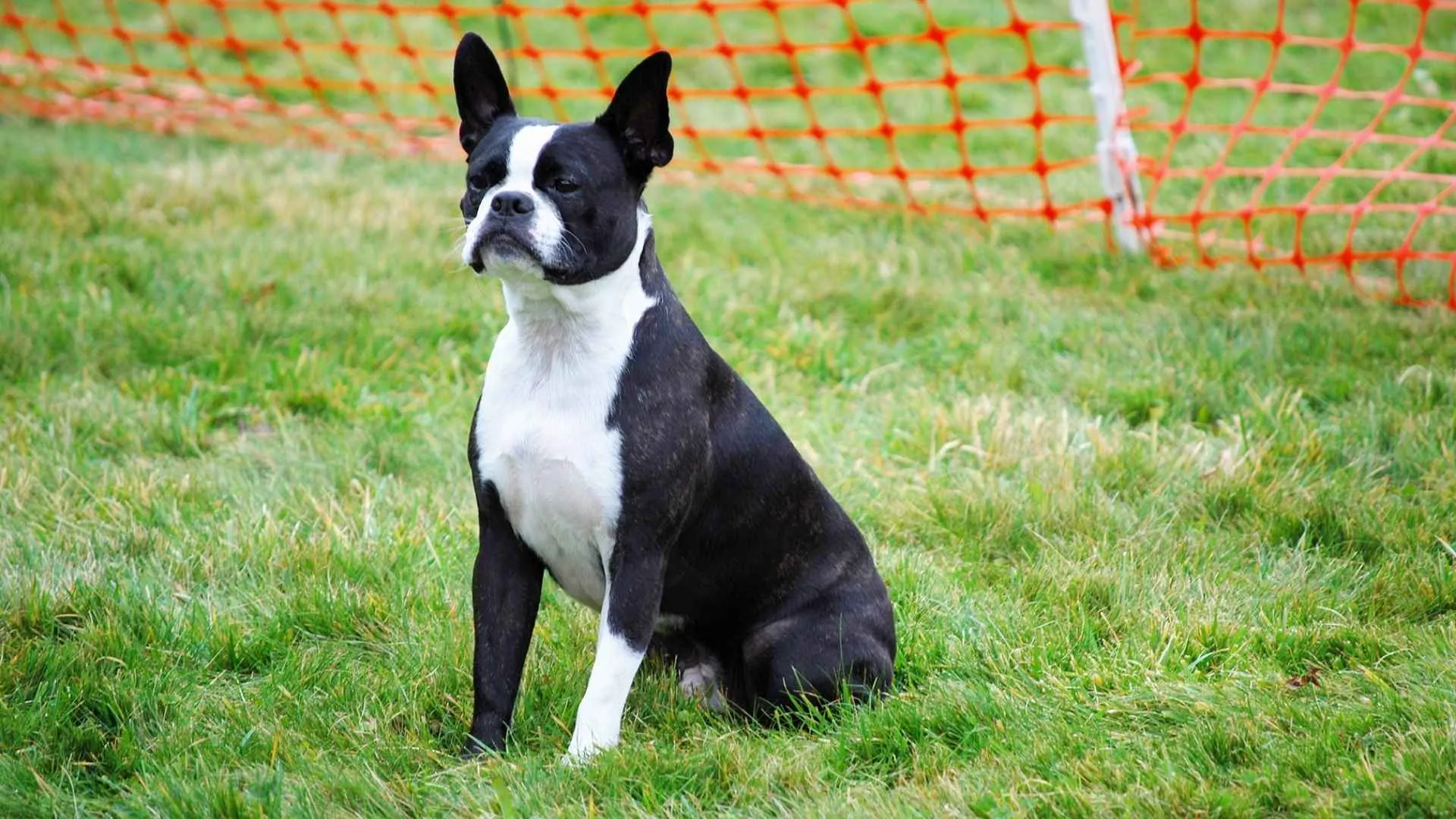
The Boston Terrier looks like he’s headed to a black-tie event but acts more like he’s crashing a barbecue with dad jokes and a belly full of zoomies. Known as the “American Gentleman,” this pup brings classy vibes and goofy energy in one stylish package.
Boston Terriers are compact, sturdy dogs typically standing about 15 to 17 inches tall at the shoulder and weighing between 10 to 25 pounds.
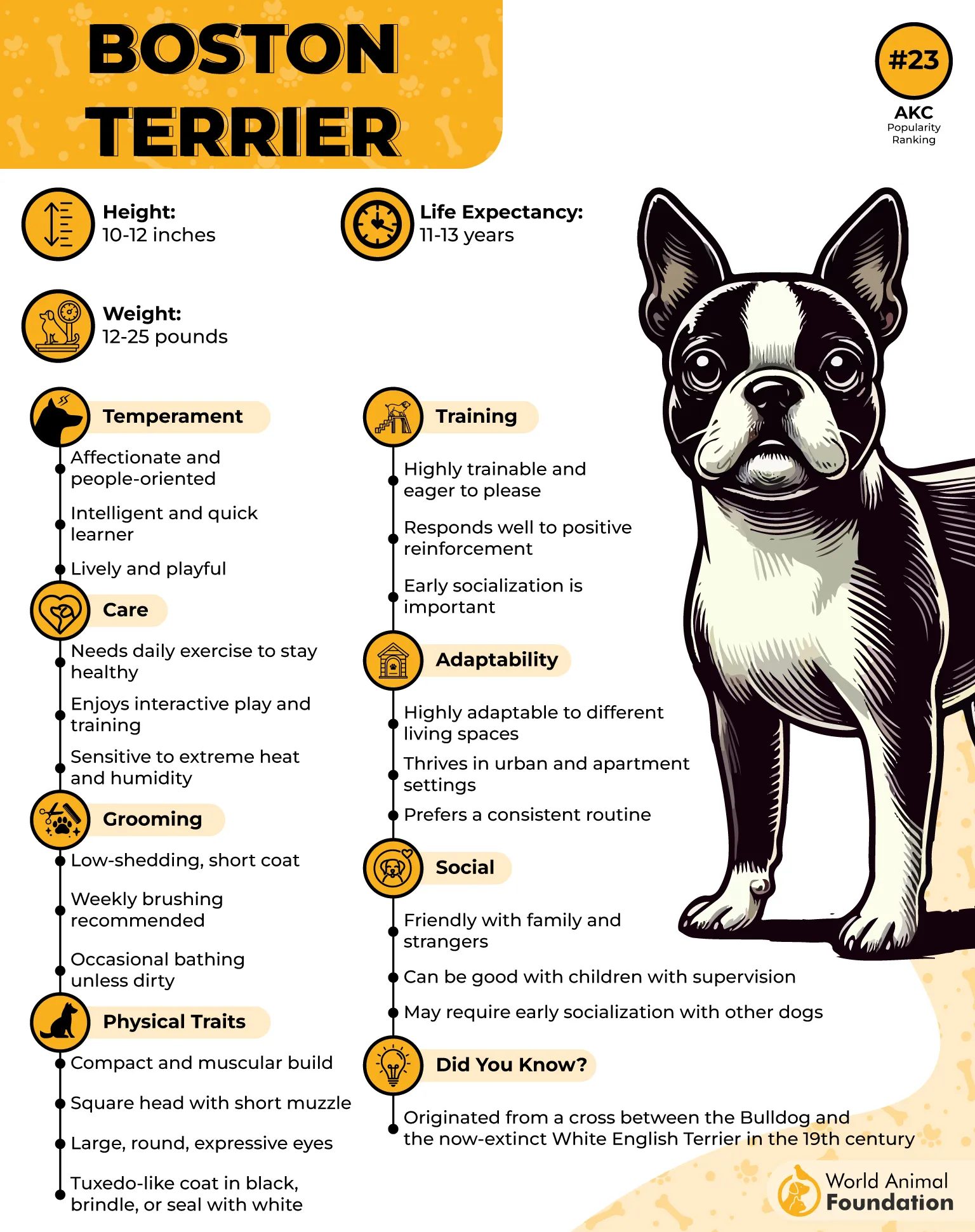
They have a well-proportioned, muscular build with a square-shaped body and a broad chest. Their most distinctive feature is their flat, “squashed” face with a short muzzle, large, round eyes, and naturally erect ears.
Living situation? Apartment living, townhouse, suburban home—they adapt to it all.
Grooming? Minimal. Their short coat is wash-and-wear, and shedding is light.
Boston Terriers are born entertainers. They’re affectionate without being clingy, energetic without being exhausting, and expressive without being yappy. They’ll keep you laughing with their hilarious snorts, epic zoomies, and cartoon-like facial expressions.
Despite their compact size, these energetic pups are lively and excel in dog sports like flyball and agility. They’re smart and quick learners, though sometimes a bit stubborn, so don’t expect them to follow every command perfectly every time.
As a brachycephalic breed, Boston Terriers have a flat, somewhat “squashed” face. Because of this facial structure, they’re prone to overheating and should be given plenty of breaks to rest when needed.
4. Havanese
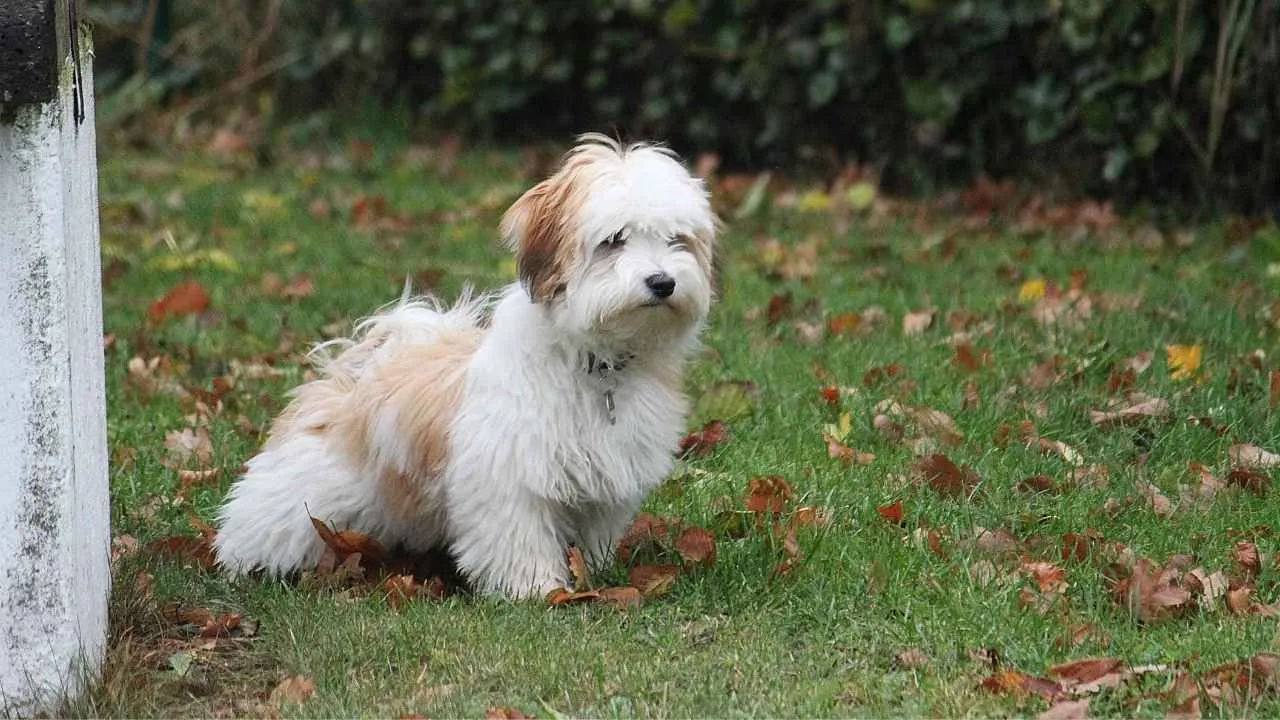
Say hello to the Havanese, a tiny fluffball with a big personality and an even bigger heart. Originally from Cuba, this breed was basically made to be your shadow—they’re happiest when glued to your side and will follow you to the ends of the Earth (or the bathroom).
Havanese dogs are small but sturdy, standing around 8.5 to 11.5 inches tall and weighing between 7 to 13 pounds.
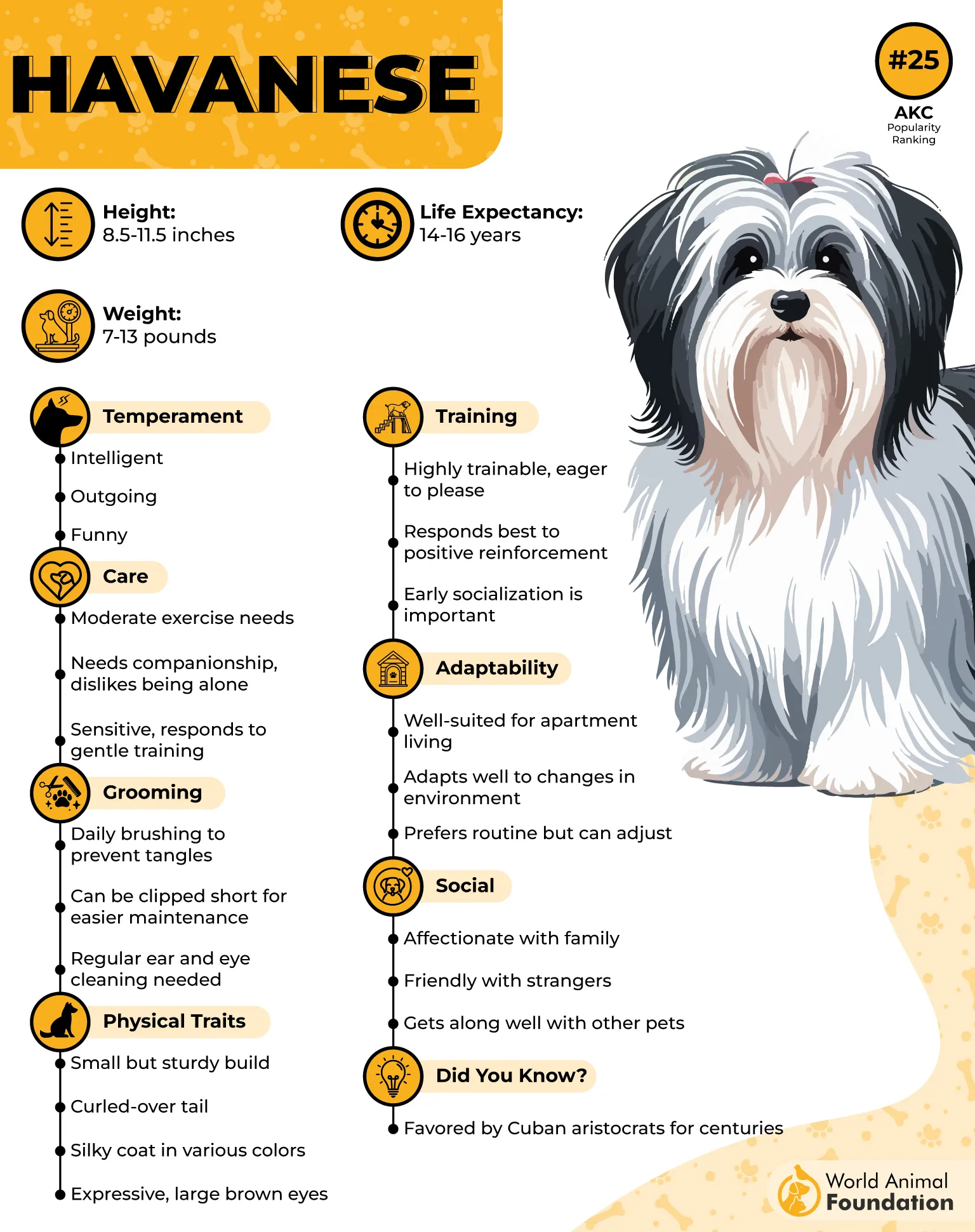
Their silky, long coat is one of their most eye-catching features — it’s soft, flowing, and can come in a rainbow of colors, from white, cream, and gold to chocolate, black, and even multicolored blends. Their expressive eyes and floppy ears give them an irresistibly sweet, almost puppy-like face no matter their age.
Vibe? Cheerful, cuddly, and charmingly needy.
Grooming? High-glam by nature, but you can go short with a puppy cut for easy maintenance.
Exercise? Light daily walks and some indoor play keep them happy and healthy.
The Havanese isn’t just a pretty face—they’re whip-smart, eager to learn, and emotionally in-tune with their humans. They’re great with kids, cool with cats, and small enough to travel like a pro. Basically, they’re the emotional support fluff you never knew you needed.
The Havanese sports a long, often hypoallergenic coat that doesn’t shed much but does need regular grooming to stay free of tangles and mats. Purina says that while not aggressive, the Havanese’s sharp alertness makes him a surprisingly good watchdog.
5. Shih Tzu
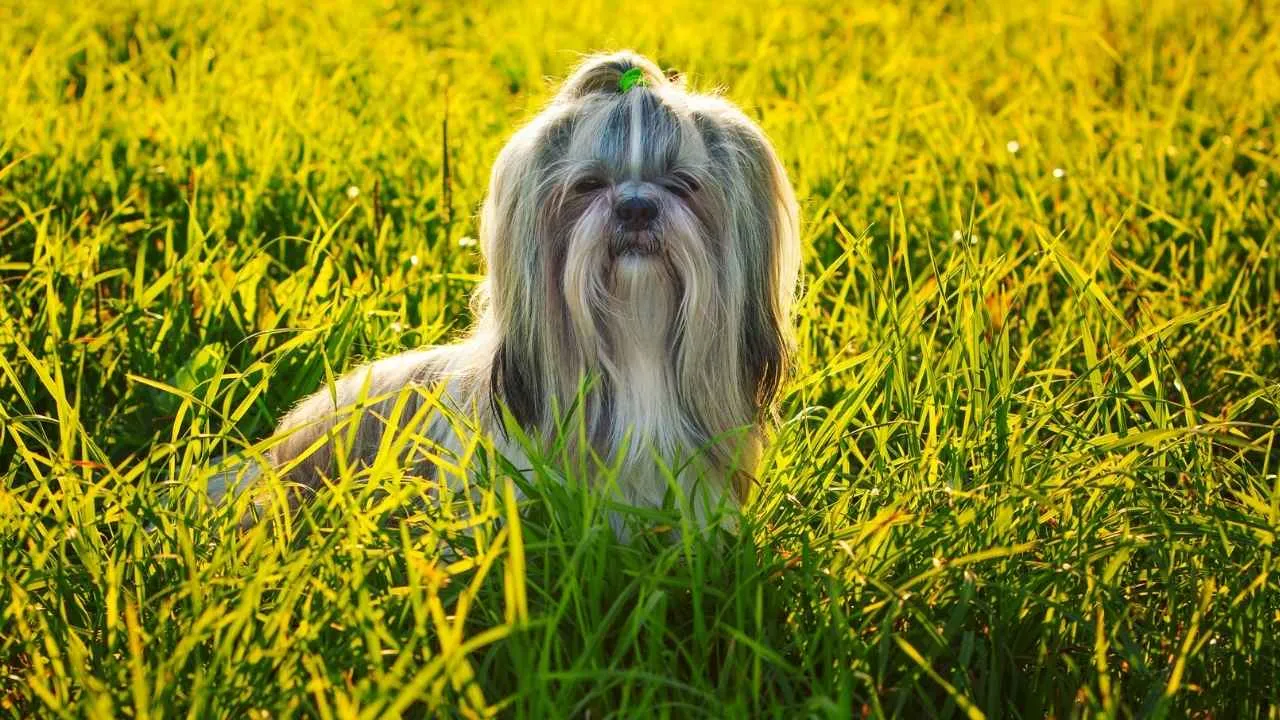
If you’ve ever dreamed of living with a royal—minus the palace drama—meet the Shih Tzu. Once bred to lounge in ancient Chinese palaces, these pups haven’t forgotten their noble roots.
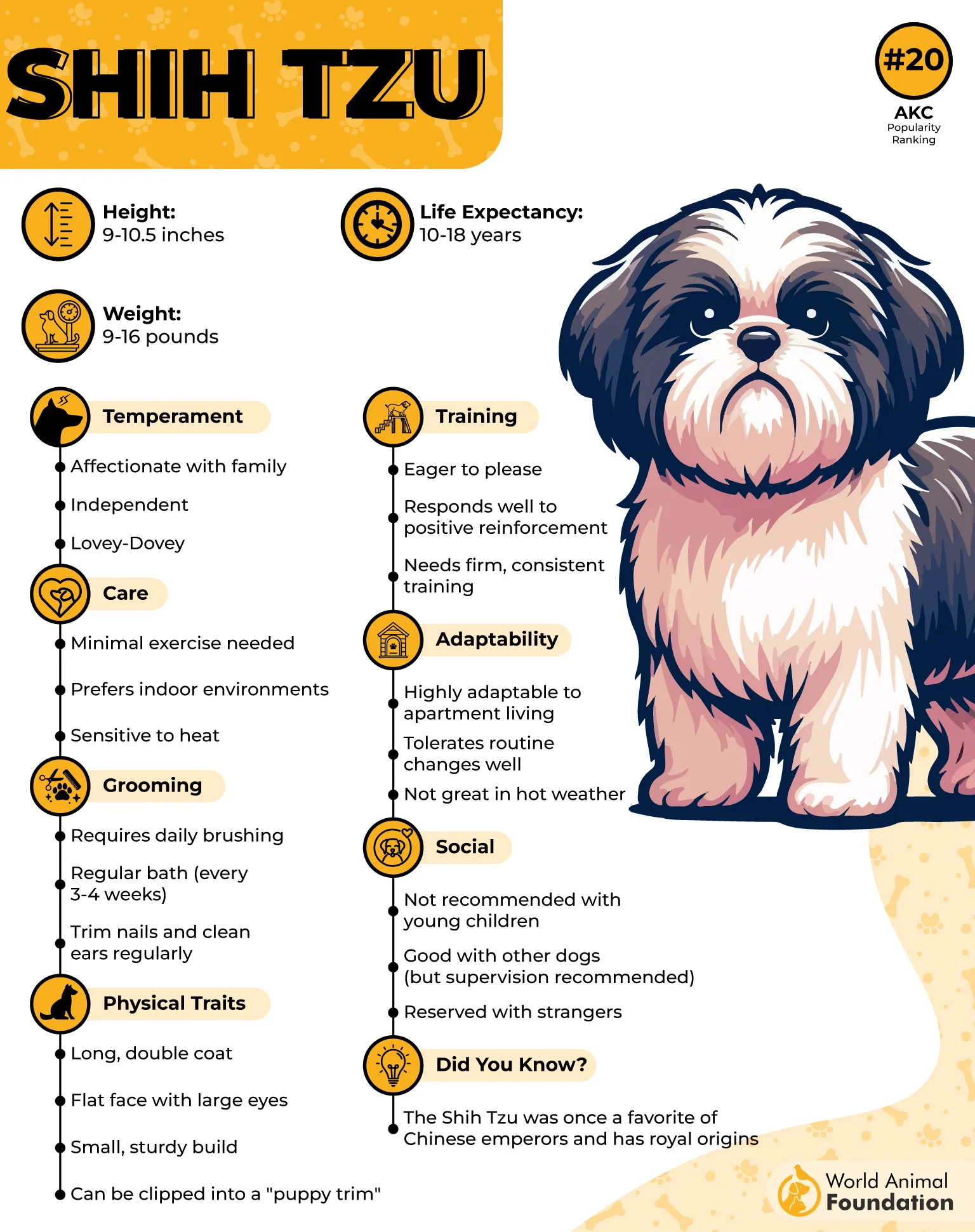
They hail from China and is believed by some to be a mix between a Pekingese and a Lhasa Apso. Its name translates to “lion” in Chinese, reflecting its regal heritage. These little dogs typically weigh between 9 and 16 pounds and stand about 8 to 11 inches tall.
Grooming needs? That glorious flowy coat needs regular brushing. Go short with a “puppy cut” if low maintenance is more your vibe.
Exercise needs? Low to moderate. A daily walk and some indoor playtime will satisfy their tiny highness.
They are affectionate, calm, and don’t need much space. They thrive on attention, adore cuddles, and are surprisingly adaptable for everything from apartments to suburban homes. They’re like little Zen masters in fur coats—happy to be wherever you are, as long as they’re included.
Because of their compact size, they don’t require much living space, making them perfect for owners with apartments or smaller homes—just be sure they have enough room to play and stay happy, as noted by WebMD.
6. Pug
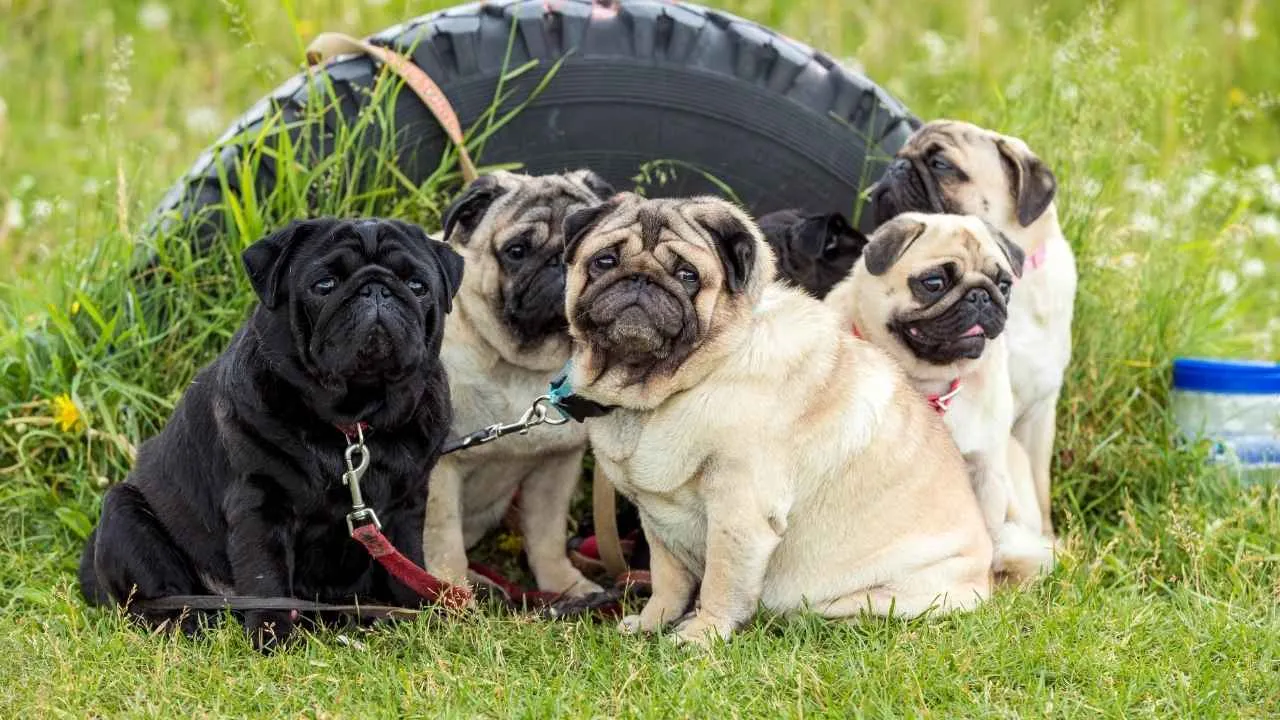
Looking for a dog that’s equal parts silly, sweet, and surprisingly deep? Say hello to the Pug, your new snorty soulmate. With a face only everyone could love, this little charmer wins over hearts with minimal effort and maximum snuggle power.
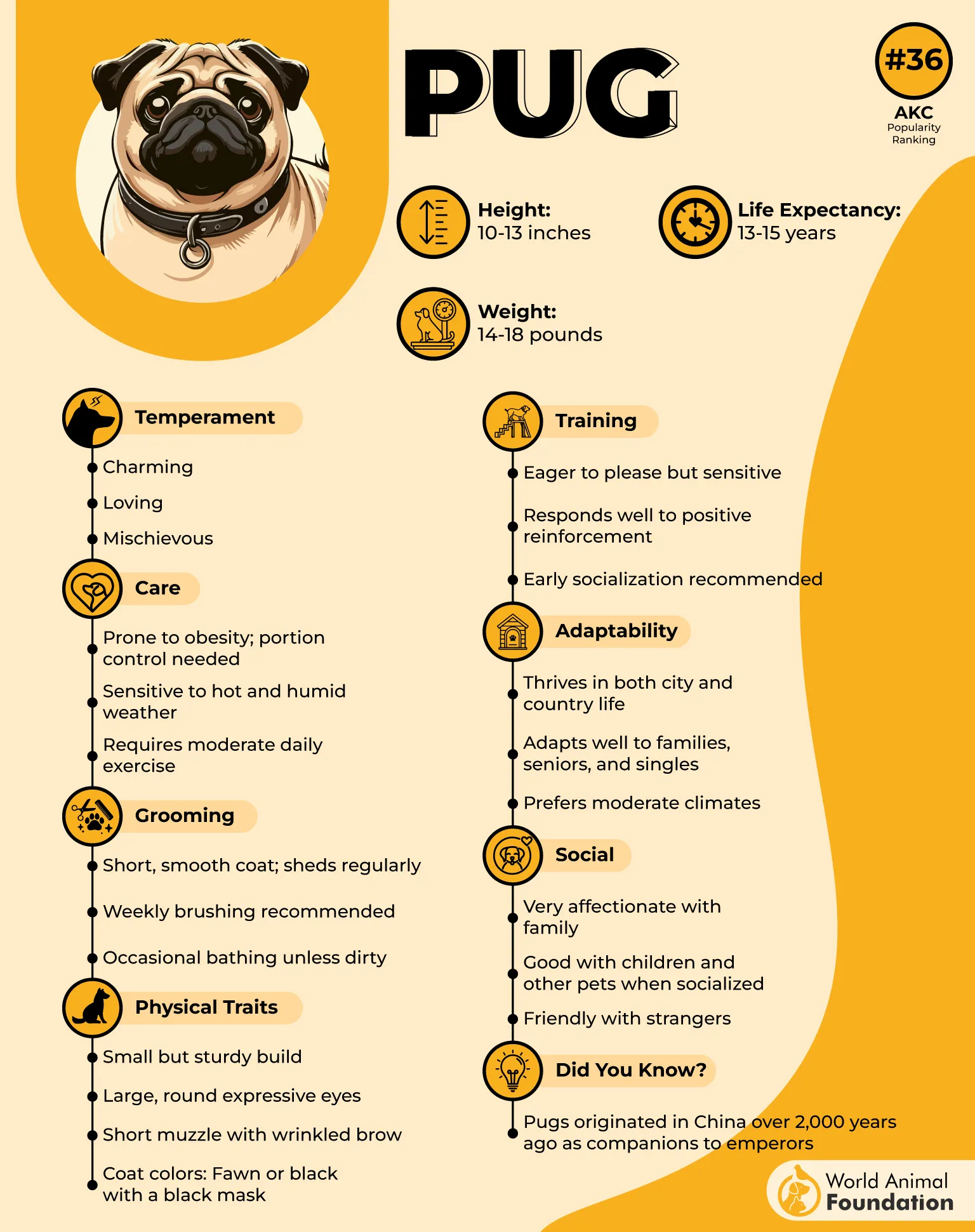
Pugs are small but solidly built dogs, typically weighing between 14 to 18 pounds and standing about 10 to 13 inches tall at the shoulder. They’re famous for their wrinkled, flat faces, large expressive eyes, and curled tails.
Personality? Comedic genius. They’re goofy, expressive, and always down for a snack (or ten).
Activity level? Moderate. Pugs enjoy playtime but won’t pressure you into running marathons.
Pugs are true Velcro dogs—they follow you everywhere like a roly-poly shadow. Whether you’re making coffee or binge-watching crime documentaries, they’re right there with you… probably snoring. Loudly.
Because of their brachycephalic (flat-faced) structure, pugs can be prone to breathing issues and overheating, so it’s important to keep them cool and avoid excessive exercise in hot weather. They need regular grooming to manage shedding and wrinkle care to prevent skin infections.
7. Pomeranian
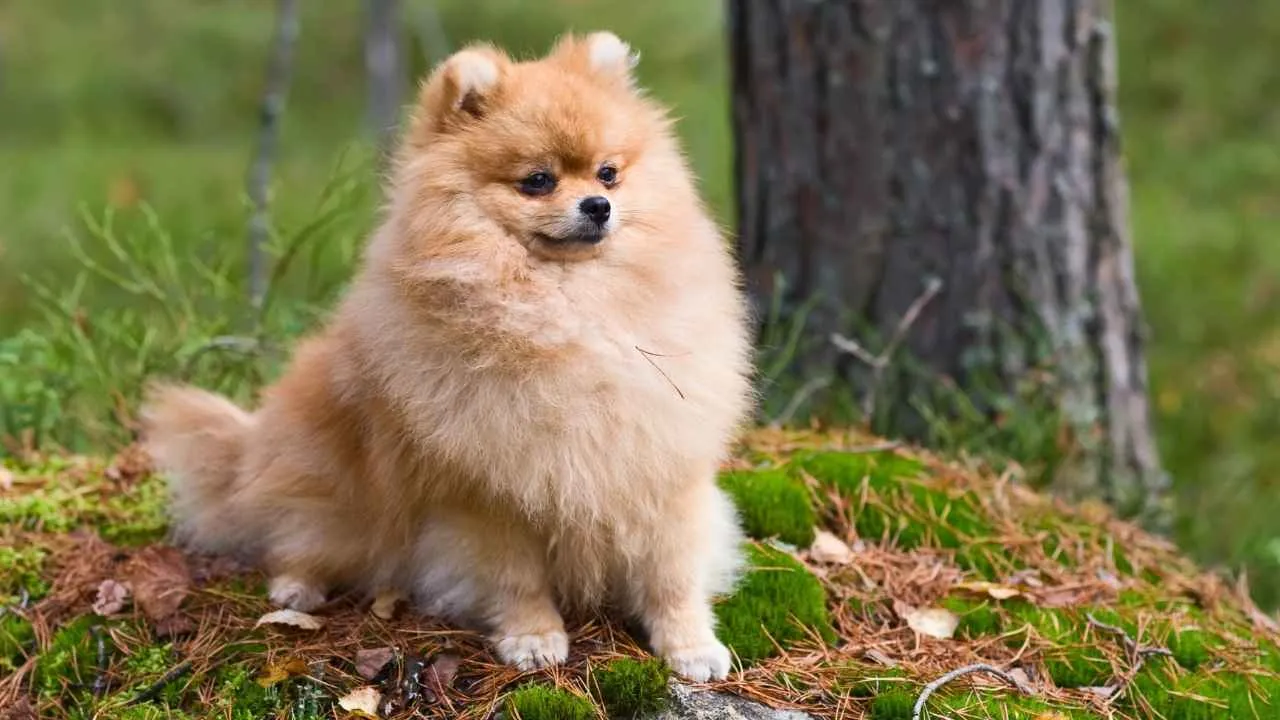
If the Pug is the class clown, the Pomeranian is the tiny executive who runs the house with a high-pitched bark and a whole lot of fluff. Don’t be fooled by the toy-sized body—these dogs pack a huge personality in a teacup frame.
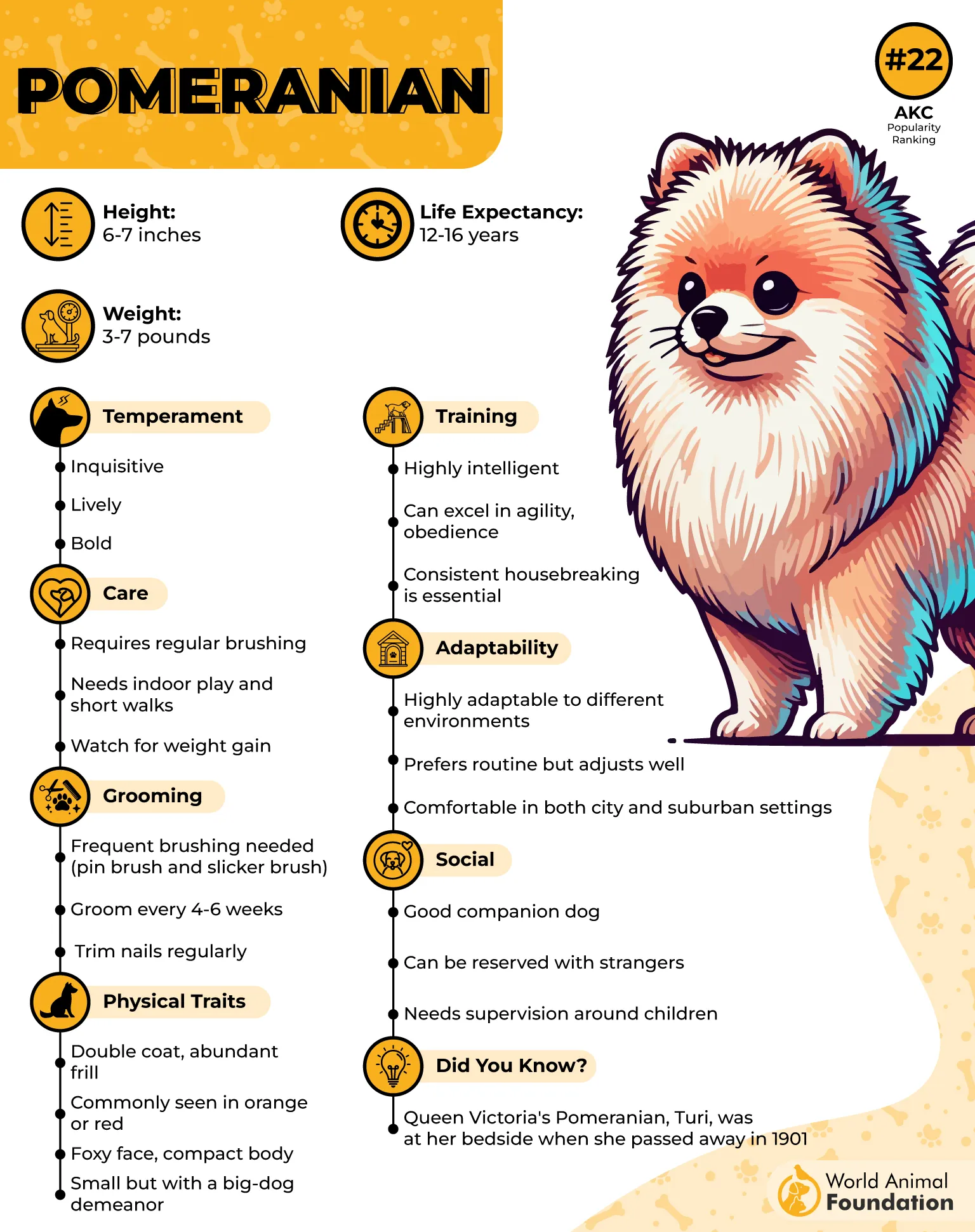
Now, Pomeranians rank among the smallest dog breeds, standing just 6 to 7 inches tall and weighing between 3 and 7 pounds. Pomeranians sport a foxlike face, a thick ruff around their neck, a compact, square-shaped body, and a fluffy double coat that makes them look like little furballs.
Smart? Very. They learn fast, and they learn exactly how to manipulate their humans.
Grooming? That majestic puffball coat needs regular brushing to stay glam (and knot-free).
Poms are super alert, often vocal, and incredibly entertaining. They’ll “guard” your house like it’s Fort Knox—except they weigh seven pounds and have the bark of a squeaky toy. Perfect for people who want a lapdog with a little attitude and a lot of love.
With an average lifespan of 12 to 16 years, they’re among the longest-living and healthiest dog breeds. However, like all dogs, they can be prone to certain health issues as they age.
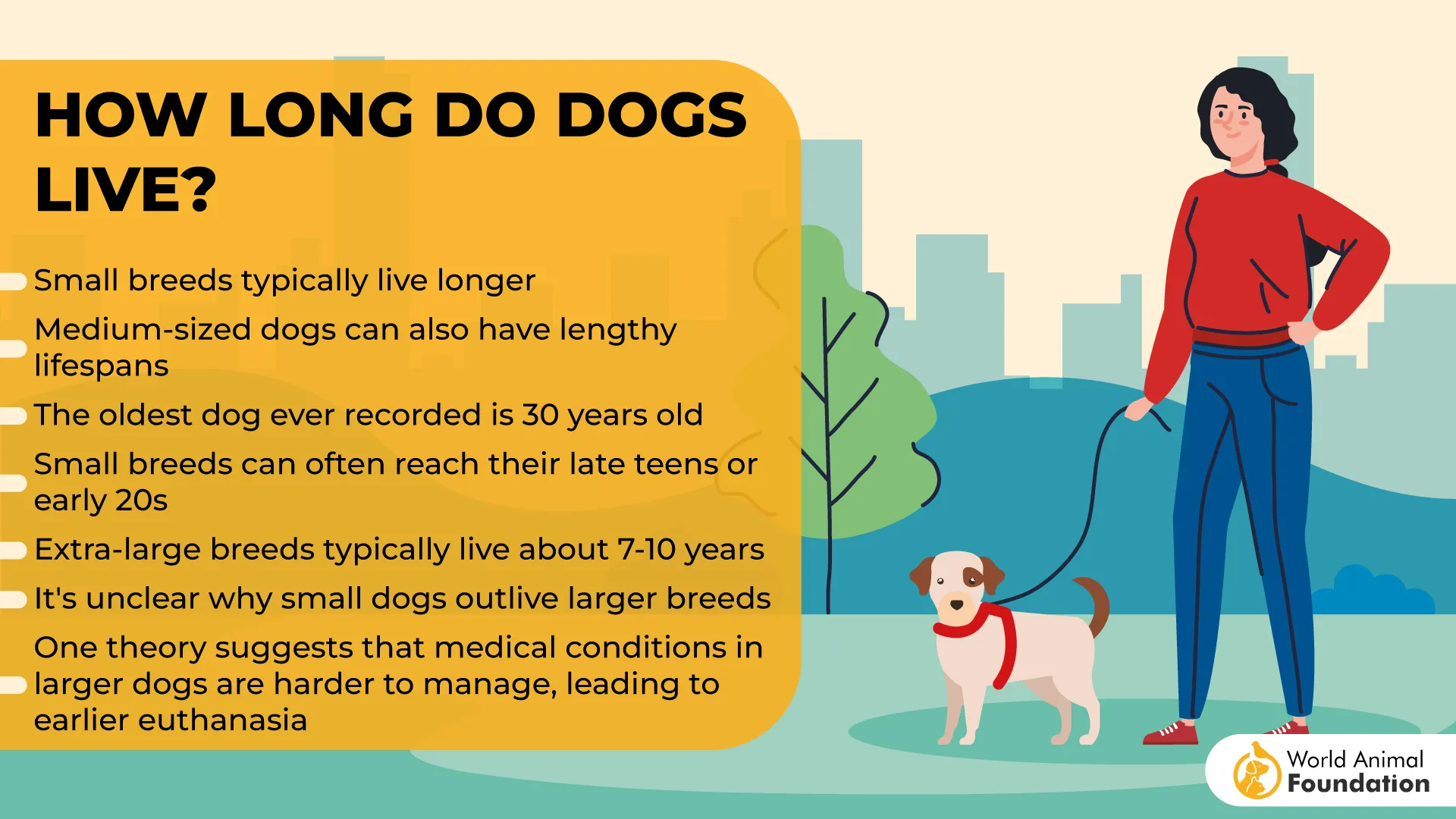
8. French Bulldog
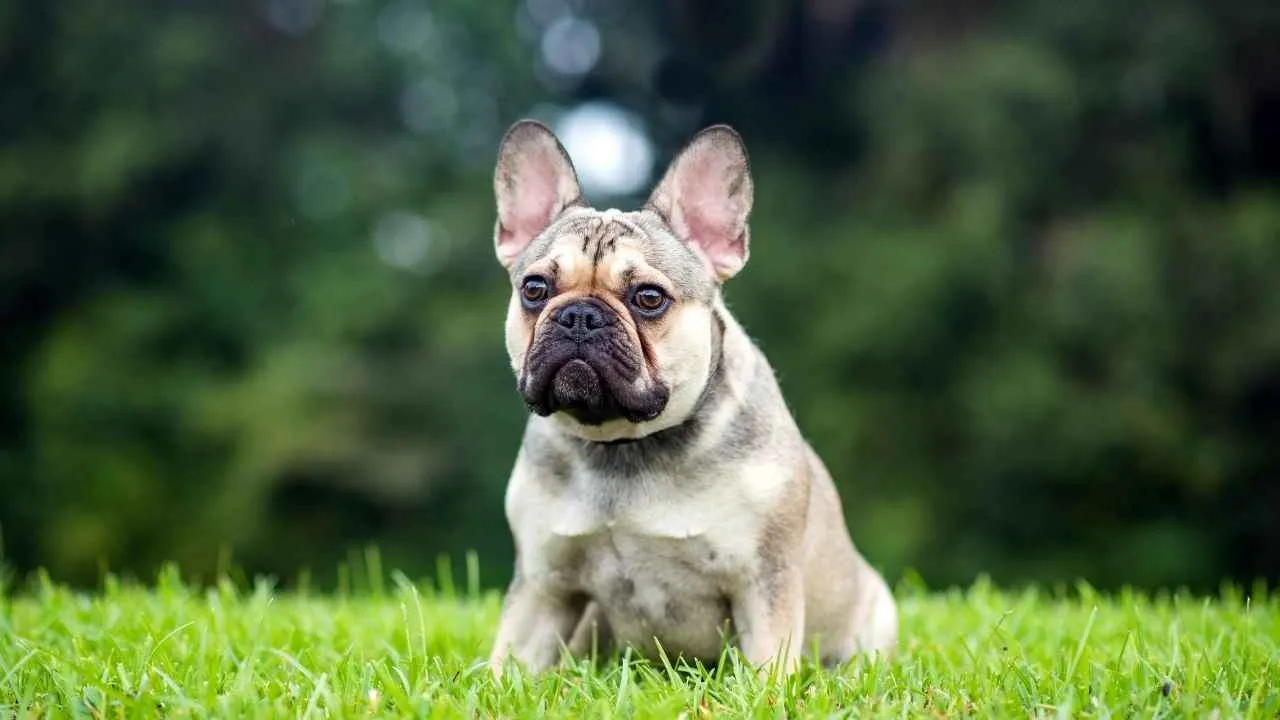
Don’t let the grumpy old man face fool you—French Bulldogs are lovable goofballs in compact packages. These pint-sized charmers were basically made for apartment dwellers who want a loyal sidekick that doesn’t need to jog five miles before breakfast.
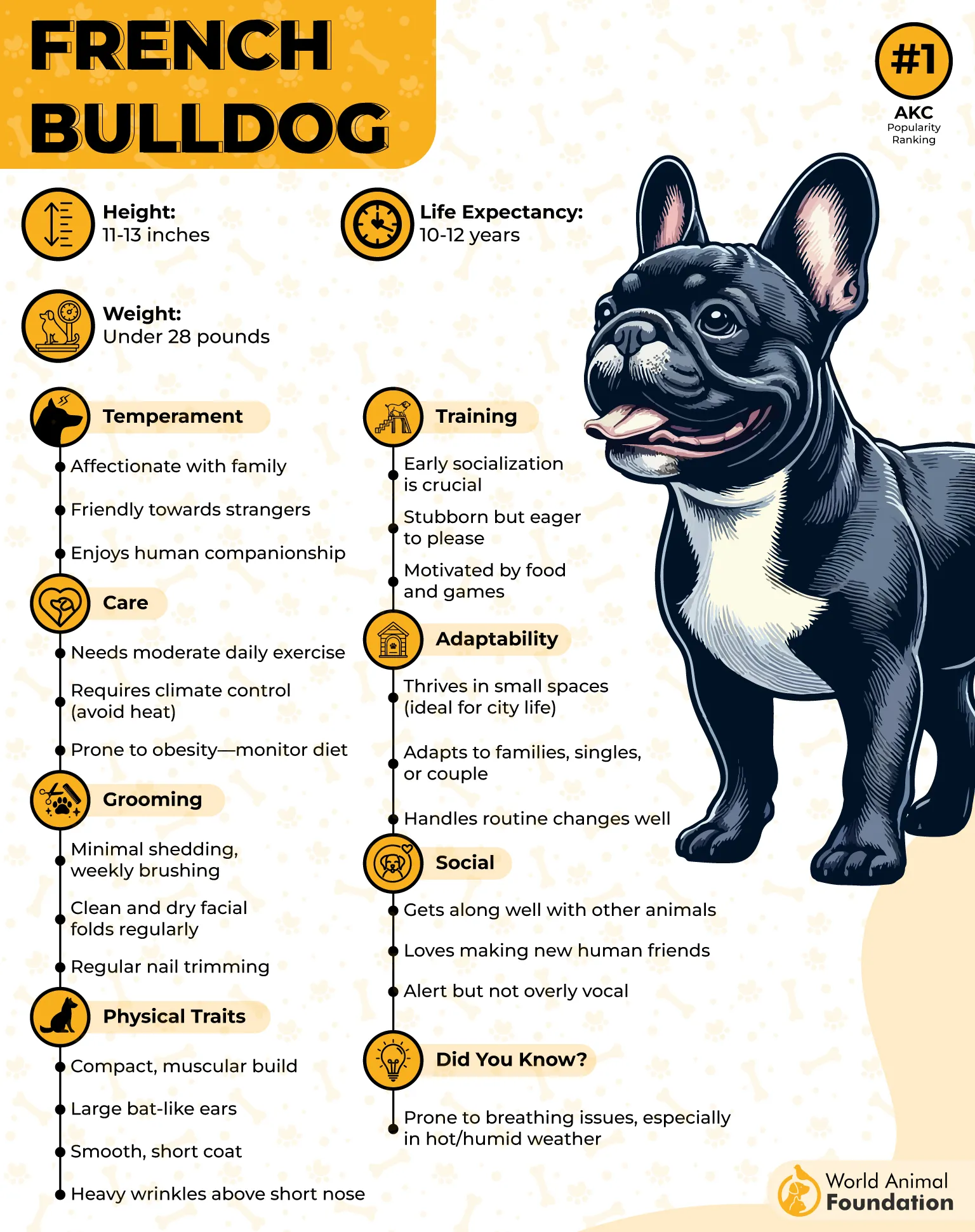
They are compact, muscular dogs typically weighing between 16 to 28 pounds and standing about 11 to 12 inches tall at the shoulder. They’re instantly recognizable thanks to their distinctive “bat ears,” short snub noses, and wrinkled faces.
Energy level? Moderately low. Their favorite workout is waddling from the couch to the food bowl (maybe with a little detour to sniff your shoe).
Grooming? Easy-peasy. Their short coats don’t shed much, and a quick weekly brush will keep them looking sharp.
Space needs? Almost none. They’re built for city life—or at least small-home lounging.
Frenchies are people-oriented and do not appreciate being left out of the loop (or the room). Expect some dramatic sighs and epic side-eye if you walk past them with a sandwich. They’re also known to snore like a chainsaw, but hey—some people pay good money for white noise.
9. Great Dane
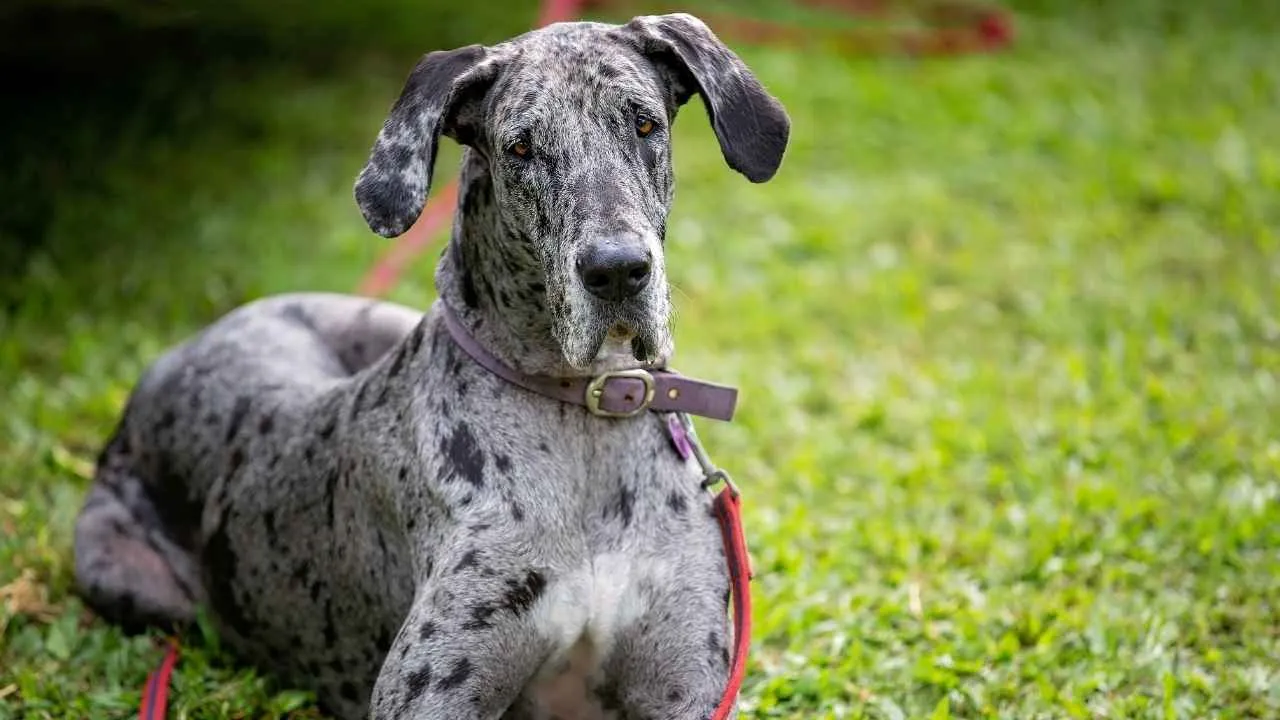
Picture this: a dog the size of a small horse, with the soul of a sleepy teddy bear. That’s the Great Dane, aka the “Apollo of dogs.” Regal? Yes. Intimidating? At first glance. But behind that towering frame is a sweetheart who just wants to lean against you like you’re a living pillow.
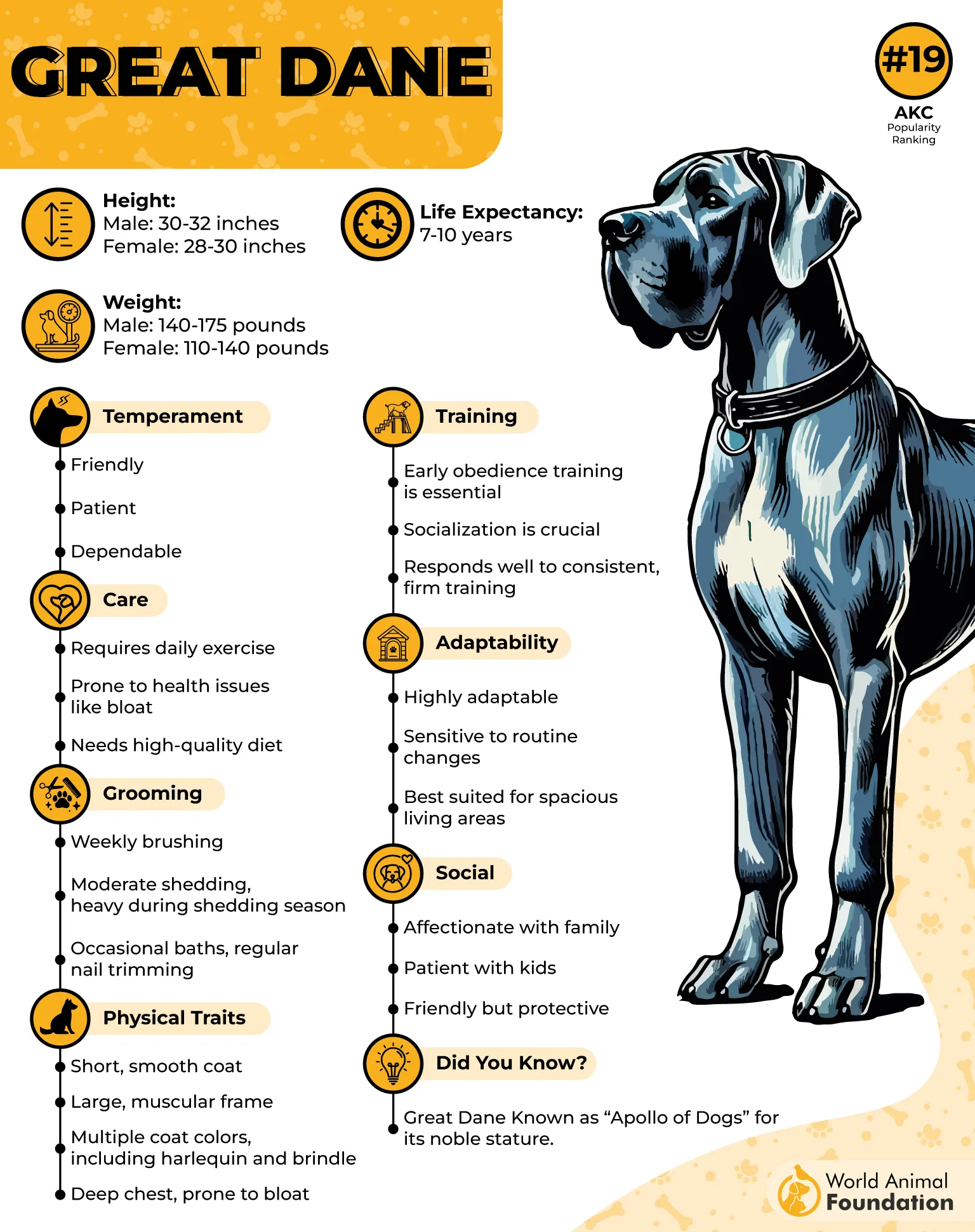
Great Danes are known not just for their height but also their impressive weight, typically ranging between 110 and 175 pounds. Standing tall at about 28 to 32 inches, these gentle giants are among the largest dog breeds.
When properly trained and socialized from a young age, Great Danes make wonderful family pets and usually get along well with children. However, because of their massive size, it’s important to always supervise interactions between kids and Great Danes to ensure everyone stays safe and happy.
Temperament? Exceptionally calm. They’re more likely to chill beside you than chase squirrels.
Exercise needs? Surprisingly manageable. One or two good walks and a romp in the yard, and they’re good.
Despite their stature, Great Danes are among the best “starter large dogs” because of their laid-back personalities. They’re gentle with kids, friendly to strangers (after a sniff inspection), and often think they can still curl up in your lap—even when their legs are hanging off on all sides.
Conclusion
When choosing the right dog as your first dog, certain breeds stand out for their adaptability and ease of training. Classics like the Labrador Retriever, Golden Retriever, Yorkshire Terrier, and Bichon Frise are known as nice dogs with happy, friendly temperaments. Even mixed-breed dogs can be the best breed with proper care. While some working dogs like the German Shepherd or Border Collie need mental stimulation and positive training, they can be amazing for spending time with active families.
Terrier breeds such as the Rat Terrier or Basset Hound are also great dogs for those with moderate grooming needs and limited space. Whether it’s a big dog like the Bernese Mountain Dog or a high-energy pup like the Siberian Husky, first-time owners should consider how much room, time, and commitment they can offer their adult dog. With a good breeder, consistency, and the right expectations, many dogs can become house-trained, loyal companions for their entire life—or even for two dogs, if you’re ready!


